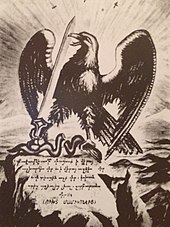Zegakron
Zegakron and the ideology of Zegakronism named after him (English Tseghakronism , Armenian: Ցեղակրոնություն translit. Tseghakronutyun) is the name of an ultra-nationalist political movement for the renewal of the spiritual and cultural identity of the Armenians . "Zegakron" literally means the bearer of the race , which is meant in a spiritual and biological sense and is also embodied in the symbol of the movement, the eagle of Taron with both Christian and fascist features . Zegakron is often translated somewhat loosely as a race religion .
Foundation and importance in the 1930s

The movement was founded in Boston in 1933 by the Armenian nationalist Garegin Nschdeh and his comrades Hayk Asatryan and Nerses Astvatsaturyan. In constructing his ideology, Nschdeh was inspired by the racial theories and fascist programs prevalent in the 1930s . In addition to the liberation of Armenia from Soviet rule, Nschdeh, together with leading figures of the Dashnaks such as Artasches Abeghjan and Wahan Papasjan (members of the Armenian National Committee founded in Berlin in 1942) , strived for the racial purity of the Armenians. Nschdeh and Drastamat Kanajan (General Dro) tried in the 1930s to convince the NSDAP officials that Armenians are part of the Aryan race. The political scientist Volker Jakobi described the relevant views of Nschdeh as extremely fascist, which was considered one of the reasons for his exclusion from the Armenian Revolutionary Federation (ARF). The organization was subsequently renamed the "Armenian Youth Federation". The British journalist and Caucasus researcher Thomas de Waal is also of the opinion that Nschdeh had aimed at purely fascist goals with the initiation of Zegakron.
At the core of the zegakronism propagated by Nschdeh was the “nation”, without which the complete existence of an individual would not be possible. He basically divided Armenians into three groups: a) Zechamard (the best part of the Armenian nation); b) Chokhovurd (hesitant and indecisive part); c) Takank (internal enemies, the so-called "anti-national devil forces ")
Continuation of the ideology
With Zegakronism, Nschdeh also laid the foundation stone for the theory of "Armenism", according to Abramjan, whose motto was: "Armenia only for the Armenians". The ideology of Taronism (Տարոնականություն) is considered an organic part and later continuation of zegakronism. The ultra-nationalist and conservative ideology of the dominant party of Armenia since 1993, the Republican Party of Armenia, is considered a continuation of Taronism and is strongly inspired by the Zegakron movement. This can also be seen in the monument in honor of the founder of zegakronism, Nschdeh, which was solemnly unveiled in May 2016 in the center of the Armenian capital Yerevan . The President of Armenia, Serzh Sargsyan , took part in the ceremony and paid tribute to the services of the "great statesman".
The glorification of Nschdeh led to resentment between Armenia and Russia. At a press conference, Maria Sakharova , spokeswoman for the Russian Foreign Ministry, expressed her lack of understanding of this step on the part of the Armenians: "Everyone knows our attitude towards the advances aimed at glorifying any manifestation of Nazism, neo-Nazism and extremism."
Individual evidence
- ^ Vahe Sahakyan: Between Host-Countries and Homeland: Institutions, Politics and Identities in the Post-Genocide Armenian Diaspora (1920s to 1980s). University of Michigan, Ann Arbor 2015, pp. 255, 271 .
- ↑ Antranig Chalabian: Dro (Drastamat Kanayan): Armenia's first defense minister of the modern era . Indo-European Publishing, Los-Angeles 2009, ISBN 978-1-60444-078-2 , pp. 243 .
- ↑ Volker Jacoby: contours of the internal conflicts in Armenia . Ed .: Johann Wolfgang Goethe University Frankfurt am Main. Frankfurt am Main 1998, p. 148 .
- ↑ Thomas de Waal: Great Catastrophe. Armenians and Turks in the Shadow of Genocide . Oxford University Press, Oxford 2015, pp. 112 .
- ↑ Kaarina Aitamurto / Scott Simpson: Modern Pagan and Native Faith Movements in Central and Eastern Europe . Acumen Pub, Durham 2013, ISBN 978-1-84465-662-2 .
- ↑ Владимир Розетти: Имеем ли мы право судить? June 23, 2016. Retrieved December 24, 2017 (Russian).
- ↑ Абрамян Э. А .: Взаимоотношения армянских эмигрантских организаций с аналогичными объединениями из–1924 Кавказа в 1924. Retrieved December 24, 2017 (Russian).
- ↑ Tigrane Yégavian: Good news from Yerevan, Le Monde Diplomatique June 2018, p. 11 .
- ↑ Вартан Давидян: Памятник герою Армении, обвиняемому Россией в связях с нацистами, рассорилв Мос Еку. June 20, 2016, Retrieved December 24, 2017 (Russian).
- ↑ Артур Папян: России « непонятно », почему в Армении установлен памятник Гарегину Нжде . In: Радио Свобода . ( azatutyun.am [accessed December 24, 2017]).

